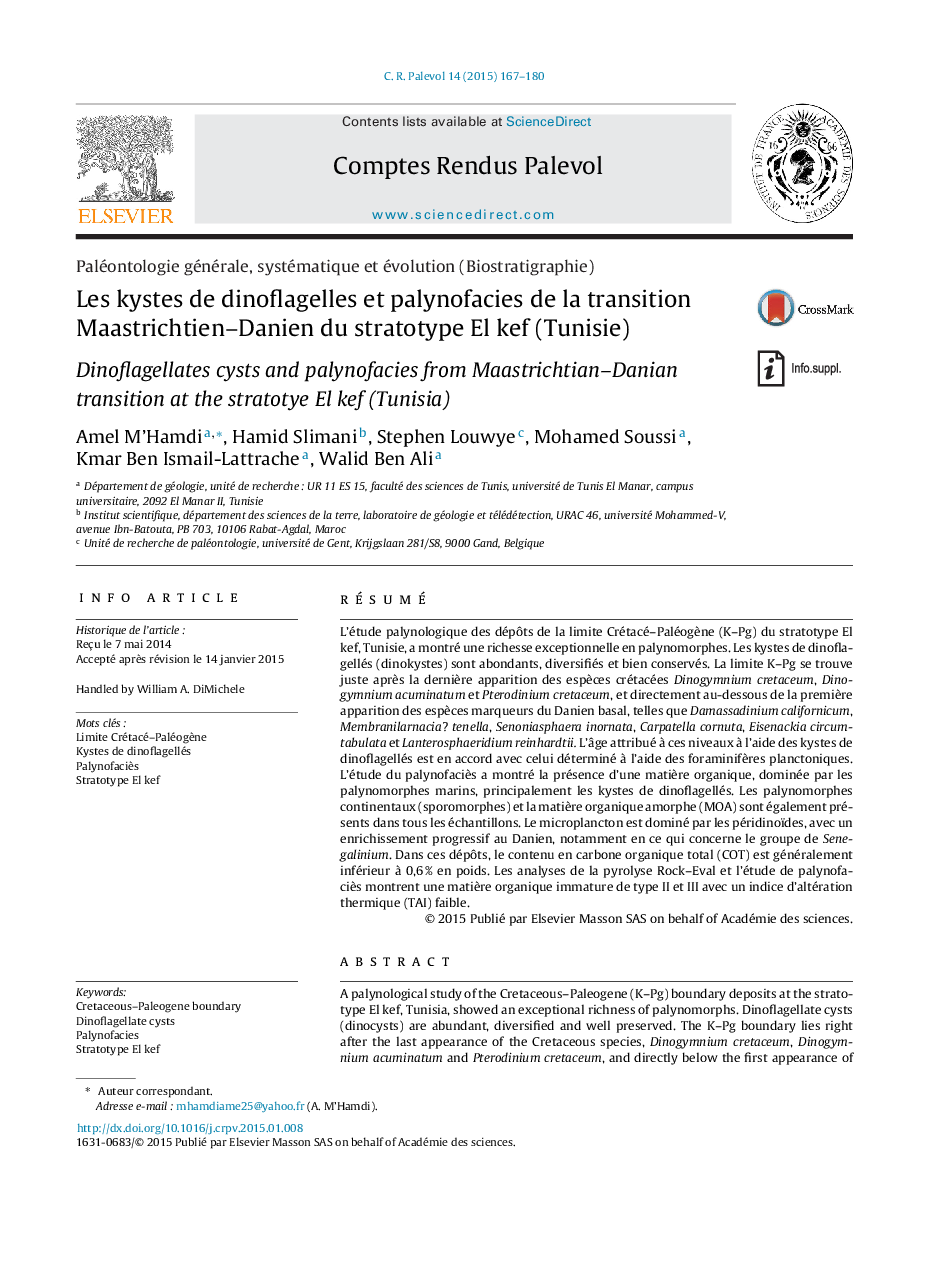| کد مقاله | کد نشریه | سال انتشار | مقاله انگلیسی | نسخه تمام متن |
|---|---|---|---|---|
| 4745731 | 1359778 | 2015 | 14 صفحه PDF | دانلود رایگان |
RésuméL’étude palynologique des dépôts de la limite Crétacé–Paléogène (K–Pg) du stratotype El kef, Tunisie, a montré une richesse exceptionnelle en palynomorphes. Les kystes de dinoflagellés (dinokystes) sont abondants, diversifiés et bien conservés. La limite K–Pg se trouve juste après la dernière apparition des espèces crétacées Dinogymnium cretaceum, Dinogymnium acuminatum et Pterodinium cretaceum, et directement au-dessous de la première apparition des espèces marqueurs du Danien basal, telles que Damassadinium californicum, Membranilarnacia? tenella, Senoniasphaera inornata, Carpatella cornuta, Eisenackia circumtabulata et Lanterosphaeridium reinhardtii. L’âge attribué à ces niveaux à l’aide des kystes de dinoflagellés est en accord avec celui déterminé à l’aide des foraminifères planctoniques. L’étude du palynofaciès a montré la présence d’une matière organique, dominée par les palynomorphes marins, principalement les kystes de dinoflagellés. Les palynomorphes continentaux (sporomorphes) et la matière organique amorphe (MOA) sont également présents dans tous les échantillons. Le microplancton est dominé par les péridinoïdes, avec un enrichissement progressif au Danien, notamment en ce qui concerne le groupe de Senegalinium. Dans ces dépôts, le contenu en carbone organique total (COT) est généralement inférieur à 0,6 % en poids. Les analyses de la pyrolyse Rock–Eval et l’étude de palynofaciès montrent une matière organique immature de type II et III avec un indice d’altération thermique (TAI) faible.
A palynological study of the Cretaceous–Paleogene (K–Pg) boundary deposits at the stratotype El kef, Tunisia, showed an exceptional richness of palynomorphs. Dinoflagellate cysts (dinocysts) are abundant, diversified and well preserved. The K–Pg boundary lies right after the last appearance of the Cretaceous species, Dinogymnium cretaceum, Dinogymnium acuminatum and Pterodinium cretaceum, and directly below the first appearance of the species markers of the basal Danian, such as Damassadinium californicum, Membranilarnacia? tenella, Senoniasphaera inornata, Carpatella cornuta, Eisenackia circumtabulata and Lanternosphaeridium reinhardtii. The age determined for these levels based on dinocysts is in agreement with that determined using planktonic foraminifera. The palynofacies study showed an organic matter dominated by marine palynomorphs, essentially dinoflagellate cysts, the sporomorphs are rare. Continental palynomorphs (Sporomorphs) and Amorphous Organic Matter (AOM) are present in all samples. The microplankton is dominated by peridinoid dinocysts with a progressive enrichment at Danian, mainly the Senegalinium group. The Total Organic Carbon (TOC) content is generally less than 0.6 wt %. The TOC, Rock–Eval pyrolysis and palynofacies analyses indicate that the El Haria Formation presents immature organic matter of types II and III and a low Thermal Alteration Index (TAI).
Journal: Comptes Rendus Palevol - Volume 14, Issue 3, April–May 2015, Pages 167–180
